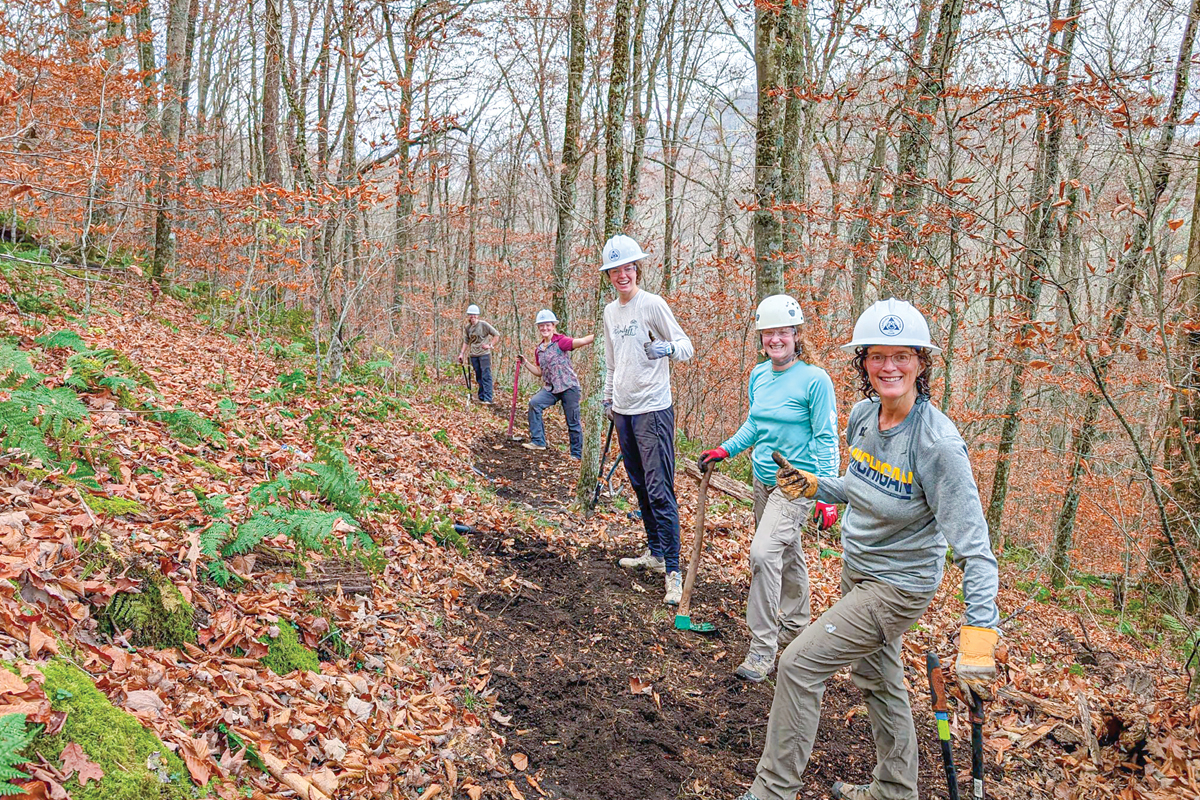One seat with two contenders put Democrats in quandary over state House race
Two well-known Waynesville Democrats running against each other for a shot at representing mountain people in Raleigh so far are playing fair and keeping the race clean.
But their similar platforms, progressive rhetoric and measured campaigns mean voters deciding between Joe Sam Queen and Danny Davis will likely be left to size up the man behind the race rather than the policies they stand for.
“There is little he wouldn’t say in his stump speech that I wouldn’t say ‘Amen’ to,” Queen said of Davis. “This is a Democratic primary, and Democrats have to choose among their friends. I have heard ‘I like you both’ more than once.”
The two men are vying for a seat in the N.C. House of Representatives representing Jackson, Swain and the greater Waynesville and Lake Junaluska area of Haywood County. The winner will run against Mike Clampitt, a Republican from Swain County, come November.
The seat suddenly came open this year when Rep. Phil Haire, D-Sylva, announced he would retire. Haire has served seven terms. Queen and Davis quickly emerged as Democratic contenders following Haire’s decision.
Both men lament the budget cuts witnessed under Republican leadership as being too harsh and decry Republican leadership for taking the state in a regressive direction.
But those arguments will play out in excruciating detail come the general election in November when facing an opponent from the other party. For now, in this civil race between two Democrats, Queen and Davis are left trying to convince voters they have the experience needed to get the job done.
Davis spent 26 years as a District Court judge in the seven western counties, what he calls a “front row seat” on the issues affecting people’s lives.
“There is no better training than being a District Court judge when it comes to seeing the problems people in our community face,” Davis said. “If there is a new drug on the street, we are the first to see it. If the economy is bad, we are the first to see it. People lose their jobs and can’t pay their child support.”
Davis has even witnessed the struggle over health care, when people’s insurance runs out, and they turn to credit cards to pay medical bills only to end up with collection agencies after them.
“I wish members of the General Assembly could come to court and see how people really live,” Davis said. “What they do down there has repercussions.”
Meanwhile, Queen, an architect with a side business managing a vast inventory of rental property, points to his six years spent in Raleigh as a state senator.
Queen said it’s easy for first-time candidates to draft legislative wish lists and sweeping campaign platforms. But once in Raleigh, reality sets in, something he learned the hard way his first time around.
“I have been proud, forceful and green before, and you don’t get much done,” Queen said. “I got my pocket picked plenty. There is a learning curve. Experience matters.”
Queen lost his seat in the Senate in 2010 after several hard-fought elections that saw the seat flip-flop back and forth between Queen and his Republican opponent each election cycle. Thus, his six years in Raleigh were served intermittently during the course of the past decade. Nonetheless, Queen said he can get right to work for the region thanks to the experience and relationships he’s already built in Raleigh.
“I know where the landmines are and how difficult it is to pull things off,” Queen said. “We need to have experienced legislators serving us because you get better every year. That is just a fact.”
But, Davis isn’t easily assuaged.
“I don’t think I will miss a beat when I go down there,” Davis said. “I think my experience as a judge gives me instant credibility. I think I have a much stronger background thinking through how legislation is going to affect people.”
Davis says he is familiar with the legislative process and has honed the art of approaching problems with critical and rational thinking.
“Having to sit down with folks and say, ‘Here’s where we are and here’s where we need to get,’ it doesn’t mater if you are a judge or a legislator, the art of negotiating is the same,” Davis said. “I think the best thing I have learned from being a District Court judge is how to listen. No one is ever 100 percent correct, and no one is ever 100 percent wrong.”
Davis also points to the decorum it takes to run a courtroom in a civil, respectful manner while still staying in charge.
Queen countered that his experience doesn’t stop at the steps of the legislative building, but he knows what it means to work in the private sector business world.
“I am an architect, a farmer, a businessman. I have employees and make payroll and deal with business cycles,” Queen said.
Do or die county
While Queen and Davis are both from Waynesville, the race will likely be fought and won in Jackson County — clearly the largest bloc of voters compared to much smaller Swain County and the fraction of Haywood that lies in the district.
Jackson accounts for half the likely voters who will cast ballots in the race. Swain accounts for less than 20 percent. Haywood’s partial territory accounts for slightly more than 30 percent.
The breakdown, an analysis by Queen, factors in registered Democrats as well as unaffiliated voters who typically vote in the Democratic primary.
Davis believes he has strong name recognition in Jackson County, where he served for two-and-a-half decades as judge, a post that spanned all seven western counties. Likewise, he has been serving in Cherokee as one of the three justices on the Cherokee Supreme Court and as a substitute tribal court judge.
Queen said his name is known outside Haywood from his years in the state Senate. Even though his Senate district extended to the north and east of Haywood — and did not include Jackson or Swain — his name was still out there. Queen said he partnered with other mountain legislators to get regional projects accomplished, including initiatives in Jackson even though he technically didn’t represent that county in the senate.
But to make sure, Queen is campaigning heavily on the ground in Jackson and Swain counties. He is pulling out all the stops with a series of meet-the-candidate events, complete with free food and a line-up local bluegrass bands at each. His events have run the gamut from a waffle brunch at an outdoor park in Sylva to an upscale restaurant in Cashiers.
“I have really enjoyed this primary. It has been fun, and I try to make it fun,” Queen said. “I try to have good music, good food and a good vision — the vision excites people.”
The kind of campaign Queen is running also takes money, between hiring bands and feeding anyone who shows up. Queen has a history of tapping his personal finances, spending well over half a million of his own money his later Senate campaigns.
Davis is hosting two campaign events compared to Queen’s eight.
Primary factors
There’s more than sheer population that makes Jackson a heavy-hitter in the Queen-Davis race.
Jackson County might see higher voter turnout than its neighbors thanks to a ballot measure on whether to legalize alcohol sales countywide (see article on page 12).
Democratic voters in Jackson County also have a primary contest for county commissioner, unlike Haywood or Swain.
It’s hard to predict what kind of voter turnout Davis and Queen can expect. Primaries generally don’t draw a lot of attention.
While there’s not likely to be nearly the interest as in 2008 when Hillary Clinton and Barack Obama were duking it out in the Democratic primary, it’s not exactly a sleeper either.
For starters, there’s the referendum on a constitutional amendment that would ban same-sex marriages and civil unions that is bound to turn out voters who otherwise would sit out the primary.
Democrats also face the task of picking their nominees to run for governor and congress, in the wake of the political retirement of Gov. Beverly Perdue and Congressman Heath Shuler.
Do I vote in this race?
Yes, if you live anywhere in Jackson and Swain counties. Also yes, if you live in the greater Waynesville area, Lake Junaluska or Iron Duff in Haywood County.
The answer gets tricky if you live in Maggie Valley, as the Ivy Hills precinct lies in two different N.C. House districts. The best bet for Ivy Hills voters is to call the board of elections at 828.452.6633 and ask them to check your address. But as a rule of thumb, the Dellwood area of Maggie votes in this race. Residents of Maggie Valley proper and Jonathan Creek do not.
The primary is upon us
The Smoky Mountain News begins an information-packed month of election coverage this week. Stay tuned for coverage of county commissioner races, U.S. Congress, the same-sex marriage amendment and Jackson County’s alcohol vote.
Early voting starts April 19. Election Day is May 8.
Voters can cast ballots in either the Republican or Democratic primary but not both. Unaffiliated voters can chose which party’s ballot they want when they show up to vote.
Landslide hazard maps axed by state: Risky slopes in Jackson, Haywood to remain a mystery for now
Republican lawmakers have pulled the plug on the state’s landslide mapping unit, terminating a controversial project to assess which slopes in the mountains are landslide prone.
A team of five state geologists working on the maps are being laid-off this week, saving the state $355,000 a year.
“They are very disappointed as we all are. We felt this was important work from the perspective of public safety that had a lot of value, and we are disappointed we couldn’t complete it,” said Rick Wooten, a senior state geologist and landslide expert based in Asheville.
When the team was created in 2005, their mission was to map landslide hazards in every mountain county. The team only finished four counties: Macon, Buncombe, Henderson and Watauga.
The unit was working on Jackson County when it halted in its tracks.
“I thought it was an added benefit and I was glad we were at the front end of it,” said Tom Massie, an advocate for landslide mapping in Jackson County who serves on the Mountain Resources Commission. “Anyone getting ready to buy a piece of property or build a home would know whether it was a suitable site. Now they are going to have to proceed at their own risk.”
Haywood County was next in line, but won’t being seeing its landslide maps either.
“I feel like we will be losing a valuable tool in the planning process for the land that is left to develop in Haywood County,” said Marc Pruett, an erosion control officer in Haywood County.
Landslide mapping has proven controversial, however. Critics fear the stigma of being in landslide hazard zones would make property hard to sell or develop.
“Certainly some of the legislators have been very open in their statements that they viewed these maps as a backdoor to regulation and were not the least bit sorry to see these maps go away,” said DJ Gerken, and Asheville-based attorney with the Southern Environmental Law Center.
That begs the question as to whether it was truly budget concerns and cost-savings that prompted lawmakers to target the landslide mapping. Indeed, environmental policies and funding have taken a big hit under the Republican controlled legislature. (See related story in Outdoors section.)
Rep. Mitch Gillespie, R-Marion, said landslide mapping was killed to save money — not because of an ideological stance.
“We had to make cuts throughout government this year and one of the areas that I didn’t feel like was a ‘have-to’ thing was the landslide mapping program,” Gillespie said.
But, Gillespie makes no bones about it: the state shouldn’t meddle in steep slope regulations. And Gillespie indeed feared the landslide maps would become ammunition to push through slope construction laws at the state level.
“That’s what they were doing it for,” Gillespie said of the landslide maps.
Sen. Jim Davis, R-Franklin, said he fielded a call from emergency responders in Haywood County — where several homes have been hit by landslides in the past decade — asking him not to cut the program. The landslide team was always one of the first on the scene when slides struck.
“Our role was to help out the emergency managers figure out what happened. Is it safe to work around here? Is there still unstable material up here? If there is, where might it go? Do we need to evacuate people? When is it safe to go back?” Wooten said.
If the state had plenty of money, Davis can’t say what the fate of the landslide mapping unit would have been.
“To be perfectly candid, I don’t know. That is a different conversation. Since we didn’t have the money we didn’t get to that conversation,” said Davis.
Good riddance
Not everyone is sad to see landslide maps fall by the wayside. Lamar Sprinkle, a surveyor in Macon County and a member of the planning board, said he feels like Macon is penalized as one of the four counties to have completed maps.
“As a property owner I would think if my property lay in one of these zones, it would devalue my property,” Sprinkle said.
Sprinkle said a prospective buyer from out of state would likely be turned off from property that falls in landslide zone, without knowing exactly what that meant.
“If I went down to the coast and there was some kind of red flag throwed up to me that I didn’t totally understand, I probably wouldn’t buy that piece of property,” Sprinkle said.
Sprinkle said he doesn’t understand how the maps were arrived at and is hesitant to take them at face value. He said the maps are a knee-jerk reaction to the Peek’s Creek tragedy. While a tragedy indeed, Sprinkle believes it was a random act of God. He sees landslide mapping as an arbitrary and fruitless endeavor that will do little to actually predict where a slide might hit in the future.
“There are some things we don’t have any control over,” Sprinkle said.
In wind storms, trees have fallen on homes, one even killing a couple inside.
“You don’t go passing an ordinance to make everybody cut the trees around their house,” Sprinkle said.
Ron Winecoff of ReMax Elite Realty in Franklin said Macon would be better off without the maps. He, too, fears it could devalue property.
Winecoff said Realtors in Macon have been confused over whether they are obligated to tell prospective buyers when property falls in the landslide hazard zone. Do the same rules apply as lead paint or asbestos? For now, the answer is no, supposedly.
“The state board of Realtors has told us we do not have to disclose it and so we don’t disclose it, but I don’t know whether that is right or not,” Winecoff said. “If you are aware of it, any item that effects the property adversely needs to be disclosed. Technically probably we should be disclosing those maps because they do exist.”
Critics of landslide mapping fear that property undeserving of such a label would be blacklisted and become impossible to sell.
More often that not, however, the landslide mapping would help people figure out where on a lot to put a house. Landslides follow predictable paths down the mountains, and building outside that path is usually all that is needed, say experts.
The path of a landslide is about 60 feet wide — about 30 feet to each side of the natural drainage course.
Gerken pointed to the Peek’s Creek disaster in Macon County, where 15 homes were destroyed in 2005. Those built closer to the drainage were flattened while those 10 yards to the side survived intact.
That’s why Pruett sees the landslide maps as a planning tool.
“If you had a chance to buy a piece of property and you knew where there might be a hazardous spot, wouldn’t you want to move your house 50 feet away from it? How could that not be helpful?” Pruett said.
There is, no doubt, some property in the mountains simply too steep, too unstable and too prone to landslides to build on — as unfortunate as that may be for the person who owns it and would like to sell it, Pruett said.
“Sometimes you just have to look a bear in the face and say it is a bear,” Pruett said.
But the landslide maps shouldn’t be blamed for pointing out the obvious.
While the homebuilders and real estate groups have actively lobbied against the landslide maps at the state level, not all developers are against them.
Ben Bergen, a builder in Jackson County and board member on the local Homebuilders Association, thinks the maps would have been a good tool.
“We would have liked to see it through to completion,” said Bergen, owner of the green building firm Legacy. “North Carolina is a buyer beware state in terms of property. I agree it is up to the buyer to inform themselves, but I thought it was going to very useful as a builder.”
At the very least, the maps would alert people to buy supplemental landslide insurance, Massie said. Regular homeowners insurance doesn’t cover landslides. Homeowners are out of luck — whether a home is totally flattened or the foundation destabilized due to shifting soil. They can’t sell their home, nor will insurance compensate them. Meanwhile, they have to keep paying the mortgage on a house they can’t live in. Often, bankruptcy and foreclosure become the only option.
The state has taken pity on some landslide victims and bailed them out. The state spent $3.2 million to buy out damaged areas of the Peek’s Creek slide in macon County.
Meanwhile, fixing a landslide in Maggie Valley cost the state and federal government a combined $1.4 million.
Gerken said the cost of landslide mapping would pay for itself by avoiding such disasters.
“It is an extremely affordable investment to avoid those costs,” Gerken said.
Gerken equated it to floodplain mapping, a long-standing practice that curtails building in flood-prone areas.
“Not because they happen every year, but it doesn’t make sense to build structures in an area that will likely get hit every hundred years,” Gerken said.
The maps aren’t exactly sweeping indictments of every steep mountainside. In Macon County, 11 percent of the county falls in the high landslide hazard zone. In Buncombe, its 10 percent, and just 6 percent in Henderson. Watauga comes in higher with 20 percent.
How to map a landslide
Unlike lightning, landslides nearly always strike in the same place twice. Mapping old slides is the single biggest indicator of where future slides will occur.
Many of the homes destroyed in slides over the past decade were built on top of old landslide deposits — something that landslide mapping could have warned people about, Wooten said.
“Some landslide deposits go back hundreds of thousands of years. They are usually quite large because they are an accumulation of many landslides that occur over geologic time,” Wooten said.
Wooten’s team has entered 3,000 old landslides in the state’s database so far. There are thousands more out there.
The mapping falls short of being able to predict the next slide, however.
“People say, ‘Well, where is it going to happen next time,’” Wooten said. “Eventually over geologic time it is going to reoccur.”
Geologists rely most heavily, however, on aerial photography over several decades to find evidence of slides, which remain visible for years.
In Jackson County, aerial photography from the early 1950s still revealed slides dating back to 1940, a fateful year when 13 inches of rain fell in 24 hours, triggering thousands of slides across the region.
Robbie Shelton, Jackson County’s erosion officer, was one of the team’s go-to consultants. He often acted as a guide, helping the team scout their way up mountainsides using locally known dirt roads and cart paths to reach an old slide.
After tagging along on the ground reconnaissance missions, Shelton knows what to look for and can hopefully warn builders and developers even though the county won’t have a complete map.
“I feel like I have a little better handle on it, having been out with Rick and his team, to be able to say, ‘This might not be the best place for you to think about building and you might want to consult a geotech,’” Shelton said.
The landslide unit has been working frantically to get the Jackson County maps to a good stopping point, and enter all the data they have so far into the database.
Wooten said he will drop off whatever GIS files they have done with Jackson County sometime next week, and then formally shut the books on the project.
While interesting, the half-finished map of where old landslides occurred is only somewhat helpful. The most important step — translating the location of old slides to identify low, moderate and high hazard zones — hasn’t been done.
While Wooten will remain employed as a state geologist and landslide expert, he won’t be finishing up the maps on his own.
“The message from the legislature was they do not want the mapping done,” Wooten said.
Putting the maps to work
So far, no county has banned building outright in high hazard landslide zones. What’s more likely is that landslide hazard zones will pinpoint where to impose regulations.
But of the four counties that were mapped, only Buncombe has actually done anything with them. In Henderson and Watauga, the landslide maps have found a cozy home on the shelf with no sign of being taken down anytime soon.
In Macon County, planners hope the landslide map will be incorporated into a new steep slope ordinance currently in the works. If passed by county commissioners, Macon will join just half a dozen WNC counties with slope ordinances — ranks that also include Haywood, Jackson and Buncombe.
Macon’s ordinance sets out a few simple parameters, like limiting the height and steepness of cut-and-fill slopes. On the steepest slopes, builders would have to consult an engineer.
And that’s where the landslide maps come in. Areas that fall in moderate to high landslide hazard zones would also require engineers to build on.
Wooten said that is a reasonable application for the landslide maps.
“If you were looking for a place to buy and the maps were available, you could see areas where there is a high landslide potential that would give you the information to seek additional help from geologists or engineers,” Wooten said.
But Sprinkle, who sits on the Macon planning board, doesn’t think the landslide maps have a place in the county’s ordinance, questioning their accuracy. And now that the landslide mapping team is dismantled, who can they call if they find an error in the maps, Sprinkle asked.
“There are lot of pitfalls in having maps with nobody to look after them,” Sprinkle said.
What’s next
While landslide mapping is gone for now, future lawmakers could start it back up. But a team will have to be re-assembled and the learning curve repeated.
“We paid to develop a lot of expertise in landslide mapping that we are now throwing to the wind,” Gerken said.
Landslide mapping gained traction following two back-to-back tropical storms that dumped a massive amount of rain on the mountains in 2005, triggering dozens of landslides. The most tragic was Peek’s Creek in Macon County, where five people, including a child, were killed and 15 homes destroyed.
“That was probably the event that got the attention of legislators,” Wooten said.
Gerken said the loss of life is inevitable without a more cautionary approach to siting homes.
“This short-term political decision simply cannot hold because we are going to see the consequences again,” Gerken said. “These kinds of events are part of mountain geology, and they will happen again. It is only a matter of time.”
See the maps online
To see Macon County’s landslide map, go to www.geology.enr.state.nc.us/Landslide_Info/MaconCounty.html. A partial map for Jackson will eventually be posted with a link at wfs.enr.state.nc.us/fist/.
Building districts by the numbers
This year, the math of moving districts will give virtually every western block a shift.
Sen. Jim Davis’s, R-Franklin, Senate District 50, which now claims seven counties — Cherokee, Clay, Graham, Macon, Swain, Jackson and Transylvania — plus part of Haywood, lacks around 15,000 patrons to reach the threshold.
“I know my district is going to change,” said Davis. “We’ve got to pick up 15,000 in population, but I don’t know exactly how it’s going to change. I think that I may get more of Haywood County, but I don’t know for sure.”
He could scoop up a greater share of Haywood to bring enough voters into the fold, but all of Haywood would push him over the threshold. Unless, however, Transylvania was given the boot.
 Without Transylvania, the seven western counties — Haywood, Jackson, Macon, Swain, Clay, Graham and Cherokee — perfectly comprise a Senate district. Haywood would not need to be split between two senate districts as it is now.
Without Transylvania, the seven western counties — Haywood, Jackson, Macon, Swain, Clay, Graham and Cherokee — perfectly comprise a Senate district. Haywood would not need to be split between two senate districts as it is now.
Meanwhile, on the other side of Haywood County, the horseshoe-shaped ward of Sen. Ralph Hise, R-Spruce Pine, that wraps from Haywood up to Mitchell and back down to McDowell likewise needs to expand its boundaries to bring in enough voters. This is due partly to the across-the-board district broadening the census has imposed on rural areas and exacerbated by possibly losing his existing slice of Haywood. He will likely have to shift northeast to pull in enough people.
Over in the house, Rep. Phil Haire, D-Sylva, knows his district will have some rearranging to do, as well.
“It will have to be divided. There is no way you can do it (otherwise),” Haire said. “There is a certain amount of common sense that goes in to it.”
The way he sees it, the process must start in Cherokee County, at the state’s westernmost corner, picking up the populace in pieces as it moves along.
“You have to have so many people in a district. If one county doesn’t have it you add another county, if that doesn’t do it you add in another,” said Haire.
And if you start in the corner and move steadily eastward, it’s almost certain that his district will, again, split Haywood.
House District 119, Haire’s domain, now takes in Swain, Jackson and parts of Haywood and Macon counties.
But doing east-moving math, Cherokee, Graham, Clay and Macon make a perfect district — just upwards of 80,000 people, falling neatly in the range for a House district without splitting any county. From there, it moves up toward Jackson and Swain, but those two together are 20,000 people shy of a district. So Haire would have to take a 20,000-person bite out of Haywood or Transylvania; one of the two would have to be split.
Slicing Haywood to give to Haire seems the most likely for a couple of reasons, the most practical being geography and likeness — Haywood is far more similar to and easily accessible from Swain and Jackson counties than Transylvania.
But there are, of course, political considerations as well.
Rep. David Guice, R-Brevard, holds all of Transylvania at the moment. And his party holds the power in this year’s redistricting, so it seems unlikely that splitting that historically Republican county away from Guice would be high on any Republican agenda.
Right now, Haire has a pretty small sliver of Haywood County — around 25 percent — but were he to grab from there as many votes as he needed, he’d be claiming almost half of the county.
Which brings the discussion to Rep. Ray Rapp, D-Mars Hill, who now shares the county with Haire. He would lose some of his voters in Haywood to Haire’s district, forcing him to push further north and east in a bid for a full district, claiming the whole of Yancey County into his three-county district.
Redistricting to grow mountain districts
In legislatures around the nation, it’s that time of decade again — time to break out the old redistricting maps and rehash the legislative lines.
Every 10 years, following the decennial census, lawmakers are constitutionally obliged to rearrange their districts so a roughly equal number of people are in each one, ensuring an representative Democracy of one person, one vote.
In North Carolina, the General Assembly is permanently comprised of 170 members: 50 senators and 120 representatives. Most every district will be finagled at least a little.
The state’s population grew by 18.5 percent, so the number of people in each districts must likewise grow. House districts, then, need 79,462 people. Senators now have to represent 190,710.
Since creating districts with such exact numbers would be hopelessly arduous, the rules allow for 5 percent more or less in every district.
For senators and representatives in the west, this means their districts will likely grow, pushing north and east in the pursuit of enough constituents.
This whole series of scenarios is a picture of the larger, statewide trend: over the last decade, urban areas have blown up. Rural areas, not quite so much, according to the 2010 census.
So legislators in more rural regions on the state’s mountain and coastal bookends are going to see their already-sizable districts balloon in geographic scope, freeing up legislative seats for faster-growing urban areas.
On the whole, two governing principles drive the redistricting process: equal representation among districts and districts where the predominant factor isn’t race.
Beyond that, the state’s constitution asks that counties be kept together, though as Western North Carolina proves, that’s often impracticable.
Then there’s the added political layer, which is what produces gerrymandered districts, those that are outlandishly drawn to cater to one party or politician’s interest.
In the gerrymandering game, North Carolina isn’t quite a gold-medal winner. Maryland has a few districts that resemble nothing so much as a polygraph readout, while Florida boasts a congressional region or two that look like a dot-matrix printer gone awry on a map.
But political considerations have factored into the state’s districts, and they haven’t always taken the constitutional mandates into account, splitting counties either for necessity or political consideration.
One thing nearly everyone agrees on, however, is that the future of redistricting would be a more equitable landscape if politics were taken out of the process altogether.
That’s the intent of House Bill 824, co-sponsored by Rep. Ray Rapp, D-Mars Hill, which passed in the House earlier this month.
It calls for a non-partisan, staff-penned plan that’s based on district compactness, continuity and constitutional mandates. Legislators would then give the map an up-or-down vote.
“I think what’s important is they don’t take into account the current residence of sitting members. So you don’t get into ‘oh, that’s so-and-so’s district, we’ve got to carve that out so he stays or she stays in this district,’” said Rapp.
The plan would kick in with the 2020 census and is based on Iowa’s method, which has been operating there for four decades without a single court challenge. The same cannot be said for North Carolina’s procedures.
“I think what it’ll do is ensure fairness in the process,” said Rapp. “Every decade we’ve had court challenges to the redistricting plan in North Carolina. I think there’s just a time when you say, ‘let’s do it right.’ Just do it straight up, straight forward so it’s fair and let the chips fall where they may.”
Rapp found bi-partisan support for the measure in the House, and he’s hoping for the same in the Senate.
For his part, Sen. Jim Davis, R-Franklin, said he’s not against the idea.
“Some states do it that way and it seems to work pretty well,” said Davis. “Politicians are going to be really reluctant to give up that authority, but I think that has some merit.”
The legislature doesn’t yet have a final plan for the new districts, but committees have been meeting in both chambers to investigate the task, and the whole assembly is slated to start discussing it in mid-July, with recommendations due by the end of that month.
To split or not to split
Haywood County is a split county in both chambers represented by two different legislators. But now, there’s a move afoot to pull it back into a single district. Anyone putting pencil to paper to do the math, however, has realized it simply might not be possible.
This year, Haywood County’s Republican Party is lobbying for the county to be returned to one district, arguing that two house and two senate districts are confusing to voters and dilute the county’s legislative influence.
“It would be better if we were dealing with one legislator better than two,” said John Meinecke, chair of the Haywood County Republican Party. “The fact that we’ve been separated diminishes our political authority with the people in Raliegh. We’re the largest county west of Asheville, and yet it diminishes our political authority by having it divided the way it was.”
Local Democrats maintain the opposite, saying that four is always better than two, giving the county more clout and voice than surrounding counties.
“We are well-served — or have been in the past — by having four instead of two. We’ve had two senators and two representatives. I guess it just serves our county better,” countered Janie Benson, who heads up the Haywood Democrats.
Though they’d been asked to support a resolution in favor of joining the county, county commissioners declined to take a stance on the issue earlier this month.
Golden LEAF on the chopping block
It’s no secret that the state budget is in a tight spot. In the few weeks the General Assembly has been in session, a raft of new laws already have hit the legislative floor, most proposing cuts in varying degrees of severity.
But perhaps the most debated has been Senate Bill 13, a Republican-penned proposal called the Balanced Budget Act of 2011. The bill calls for several money-moving measures that would dip into special pots of money in an effort to relieve the deficit — the most controversial being a proposal to raid the coffers of the Golden LEAF.
Golden LEAF has handed out hundreds of millions in grants during the past 12 years. Its purpose: use proceeds from the lawsuit against tobacco companies to help tobacco-dependent communities transition away from the ever-diminishing returns of the once-bumper crop and into other economic markets.
As the crown jewel of King Tobacco’s reign, few areas have benefited from the funds as much as the western counties. Haywood County alone has received more than $2.7 million in grants from Golden LEAF to fund projects such as the new Regional Livestock Market, a covered arena at the fairgrounds, a sewer line upgrade along Champion Drive in Canton and the Buy Haywood program, which helps local growers market and sell their products.
Jackson County has gotten more than $3.5 million to fund projects, though a good share of that was for regional efforts such as WNC EdNET, a program to bring broadband technology into public schools in six western counties.
Over the years, Golden LEAF has taken in $867 million and doled out just more than half of that as grants and scholarships, keeping the rest invested. Every year, the pot gets another influx of funds from the structured tobacco settlement, and that money is invested for future use.
For WNC, said L.T. Ward, that money has been invaluable, and losing it would be a hefty blow. Ward is the vice president of WNC Communities, the group that, among other things, is the driving force behind the Regional Livestock Market that’s scheduled to open next month in Canton.
The market will offer a place for local cattlemen to sell their livestock, something that’s currently missing from the regional landscape. Such a market is vital for the many former tobacco farmers who have now turned to cattle to replace their lost or dwindling profits.
That particular project got $600,000 from Golden LEAF, and more than that from the Tobacco Trust Fund, whose yearly allocation is also on the chopping block in SB13.
“If the Golden LEAF was not there, the numerous innovative ideas that are continuing to come forward would not because of lack of funding or encouragement,” Ward said. “We obviously would’ve been short of budget considerably.”
But lawmakers in favor of the bill — Republicans all, the vote was split directly down party lines — are quick to point out that no one is proposing a permanent shutdown of Golden LEAF. It’s more, they say, like a one-time emergency payment.
“We’re just taking this year’s allocation for the Golden LEAF,” said Rep. Jim Davis, R-Franklin. “The Golden LEAF still has $560 million. Their principal is still there.”
And while Davis stopped short of praising the fund outright, which many Republicans, particularly those outside rural areas, are wont to refer to as pork spending and corporate welfare, he was adamant about the proposal’s status as a temporary budget measure to cover this year’s shortfall.
But for those closest to Golden LEAF and its benefits, they’re afraid that the one-time measure will be a gateway to endless diversions of the foundation’s money away from the economically depressed communities it was created to help.
And it’s important to note that the money would be diverted for this year’s budget, which is already balanced. Next year, a $2.4 billion deficit, according to the most recent estimates, still lies in wait.
Robbing Peter
If you’re looking for a more vehement opponent of SB13 than Dan Gerlach, it would likely be a futile search. As president of Golden LEAF, he’s understandably worked up about the idea of swiping the foundation’s annual paycheck, and he’s worried that it won’t stop there.
He’s sympathetic, he said, to the legislature’s plight. There’s a pretty big gap between what they’ve got and what they need, and the cash to fill it has to come from somewhere. But he’s concerned that funneling it away from long-term economic drivers such as Golden LEAF will only lead to more fiscal heartache in the future.
“The thing we’re defending against is the precedent that it would set,” said Gerlach. “Once you start diverting funds from their original purpose into the state’s general fund, it’s easier for this to happen again and again and again. We’ve been good stewards of this money, we should be allowed to continue to do so.”
That is precisely the argument that Democratic lawmakers are making, that while once in an emergency might be appropriate, it opens the floodgates to a slippery slope of fund rediversion that will eventually bleed the original funds dry.
“The first dip into that money is the hardest,” said Rep. Ray Rapp, D-Mars Hill. After that, he said, a dip back into the well becomes easier every time.
Unintended consequences
For Rapp, however, opposition isn’t just about the slippery slope argument, but about the unintended consequences that he sees this bill fostering.
“The funds just are not going to make that significant a difference in the overall savings, but it sends that chilling effect. We’re losing funding from a key economic development source, so it’s especially hurtful for us,” Rapp said.
That chilling effect he’s talking about is one Mark Clasby knows well. Clasby is the economic development director in Haywood County, so he spends a lot of his time courting businesses from around the region and around the nation to set up shop in Haywood County. And diversions like this that take money away from funds that could — and do — entice businesses into the region create a sense of uncertainty that could frighten away potential industry.
“Golden LEAF has been instrumental in recruiting businesses,” said Clasby.
“If you don’t have that kind of funding, then you have almost stagnation. You don’t have the opportunity to have development so you can create new jobs so you can make life better for individuals.”
Not everyone agrees, of course. Brian Balfour, an analyst at conservative thinktank Civitas, has long followed — and opposed — Golden LEAF precisely because it does offer government incentives to businesses.
“I would argue that the use of these incentives causes more uncertainty,” said Balfour, because it creates an economic picture that’s at the mercy of politicians, rather than the market. “It creates an uneven playing field. What that does is it politicizes more of the entrepreneurial decisions and the way the economy grows.”
Instead of incentives, said Balfour, what the state’s economy really needs is deregulation.
Proponents of funds such as Golden LEAF, however, would counter that, after tobacco’s quick exit, WNC in particular desperately needed some help to fill the massive economic gap the departing crop left in its wake.
To hear George Ivey tell it, Golden LEAF, along with the Tobacco Trust Fund and the NC Agriculture Development and Farmland Preservation Trust Fund, have been invaluable in helping revitalize rural areas left destitute by tobacco.
Ivey is a grant writer, consultant and project manager in Haywood County who has been closely involved with many of the area’s Golden LEAF recipients, including the Regional Livestock Market.
“Those three funds are really the primary funders of a lot of projects throughout the state and throughout this region,” said Ivey. “Without them, I honestly don’t know where you turn, because they both have the money and understand the role that farming plays, not only for farmers but in the larger community.
“Those three funds understand that tobacco is gone but agriculture is still the No. 1 driver of the North Carolina economy.”
And that’s pretty much the argument made by the foundation itself: we’re helping to revitalize the rural economy at no cost to the taxpayer; let us keep doing it. Indeed, it is the ready defense Dan Gerlach has for his foundation’s mission and existence.
“Our investment earnings have been over $214 million on the investments that we make,” said Gerlach. “We have paid for grants that didn’t have to come from any taxpayers pocket.”
The subtext there is clear: isn’t a 12 percent return that’s being put back into economic development better than just dumping cash into the general fund?
And that’s a hard argument for Republican lawmakers to counter. In fact, few are trying to do so. But many are pointing at the $2.4 billion hole that’s looming on the horizon in next year’s budget, making the strong point that it has to be filled somehow, and it’s easy to see why Golden LEAF is an enticing cash cow indeed. Compare that to cutting teachers, for example, or community college budgets.
“We have to get our fiscal house in order,” said Davis. “It’s going to be painful, and our job and our mission is to spread the pain.”
What is the Golden LEAF fund?
A quick look at the history of Western North Carolina will show that there is no crop more important than tobacco. The plant has left an indelible mark on the mountain landscape, first with the streams of money it brought, and then the economic hole it has left.
Today, though tobacco itself no longer occupies a place of prominence, its economic effects are still rippling through the mountains, mostly in the form of grant money from Golden LEAF.
For the last 12 years, the region’s tobacco-dependent communities have been reaping the spoils of a massive lawsuit brought by 45 states against major tobacco companies over healthcare costs caused by tobacco use.
In North Carolina, that’s totaled nearly $1.7 billion so far, with 50 percent going straight to the Golden LEAF. The foundation — officially dubbed the Long-Term Economic Advancement Foundation — was set up to funnel that money back into the state’s tobacco-dependent communities.
While other states dropped their settlement cash straight into the general fund from the outset, North Carolina shied away from that approach, setting up Golden LEAF and other stewards — notably the Tobacco Trust Fund — to look after and dole out the settlement cash to tobacco-dependent areas in an effort to foster economic growth.
Local spending
Haywood County Agriculture and Activities Center Association, Inc.: $275,000
Construction and upgrades at the multi-purpose arena at the Haywood County Fairgrounds.
Haywood Community College: $1,573,109
Establishment of the Western Regional Advanced Machining Center at the Regional High Technology Center (RHTC).
Haywood County: $60,000
Created the Buy Haywood Market Development Project to develop a comprehensive plan to brand Haywood County tomatoes and peppers.
Haywood County Schools Foundation: $250,000
Expanded the machinist training program at Pisgah High School to meet the demand for highly skilled machinists.
Haywood County Economic Development Commission: $85,000
Funded the Buy Haywood Market Development Project which helps develop markets for Haywood County farmers.
Haywood Vocational Opportunities, Inc.: $300,000
Helped Haywood Vocational Opportunities, Inc. (HVO) expand its operations and secure additional contracts for production of medical supplies.
Haywood County Economic Development Commission: $15,000
Funded statewide feasibility study to identify demand for a poultry and rabbit processing facility in WNC.
Haywood County Schools Foundation: $50,182
Purchased an office mill and lathe for Pisgah High School metals program.
Town of Canton: $100,000
Expand and upgrade the Canton’s wastewater infrastructure in the I-40 Corridor at Exit 31.
Southwestern Community College: $75,000
E-commerce marketing plans and strategies for a three-county area.
North Carolina Center for the Advancement of Teaching: $930,186
Funding for the North Carolina Center for the Advancement of Teaching’s continuing effort to increase the number of National Board Certified Teachers.
Jackson County: $135,000
Funding for the Jackson County Green Energy Park.
Western Carolina University: $200,000
Western Carolina University’s innovative product development plan for the health care industry.
Western Carolina University: $37,000
Support for the Kimmel School Construction Training Program at Western Carolina University.
Southwestern N.C. Planning & Economic Development Commission: $2,205,539
Funded high-speed broadband connections to schools and counties in a six-county area.
Total: $6,291,016
Ballot measure would bar felons from serving as sheriff
After six felons in North Carolina ran for sheriff during the May primaries, legislators decided it was time to close that particular legal loophole.
This November, voters will decide on a constitutional amendment that would put a stop to convicted felons being able to hold a county’s top law enforcement post. State representatives this summer unanimously signed on to that amendment, forged in the state Senate. A majority of voters must now vote “yes” Nov. 2 for the constitution to actually be changed.
“I don’t believe any sheriff should have any criminal record — whether felony or misdemeanor,” Macon County Sheriff Robert Holland said this week. “No criminal background, at all.”
Currently, once they’ve served their court-ordered punishments and their citizenship rights have been returned, convicted felons can legally run for office, though they cannot carry a firearm. None of the primary candidates who ran for office were actually elected sheriff.
Still, the situation served to underscore the issue’s importance, said Eddie Caldwell of the N.C. Sheriff’s Association.
“It became a little less academic and a little more practical,” Caldwell said.
A bill pushed last year by the association did not pass because of procedural problems. Namely, there was concern that legislators would try to piggyback pet projects on the bill.
This time, however, state leaders agreed not to do that, which facilitated passage of the proposed constitutional change, Caldwell said.
Despite landslide worries, state slope rules face uphill battle
A controversial bill to regulate development on steep slopes to prevent landslides will be reintroduced in the state legislature this year after dying in committee last time.
The bill was crafted by Rep. Ray Rapp, D-Mars Hill, who said it has a “much better chance” of passing this time because people are beginning to see the value of such laws. A recent landslide in Maggie Valley that destroyed a home brought to light once again the need for such regulations, Rapp added.
The bill doesn’t say that you can’t build on steep slopes, but instead requires oversight when doing so — namely by mandating that builders consult an engineer when building on slopes that exceed a threshold of 40 percent. The bill calls on mountain counties to adopt slope laws, providing minimum standards to go by.
However, Rep. Roger West, R-Marble, said he opposed the legislation last time and likely will again because he doesn’t think landowners should be restricted.
Such regulations make it impossible to develop land and build roads, West said. The recent landslide in Maggie Valley does not change his opinion either, saying that it’s an isolated case.
Rather than the state developing a “one-size fits all” bill for steep slope development, it should be left up to individual counties to develop the laws, said West.
Macon County, which he represents, does not have such a law, nor does Swain County. Haywood and Jackson do, but they are rarities in WNC.
The recent landslide in Maggie involved a home built prior to Haywood’s slope ordinance. While county officials flagged the slope as unstable and issued warnings to the property owners, the construction was grandfathered in and didn’t have to comply.
Had the slope law been triggered at the time of construction, however, the slide likely wouldn’t have occurred, county officials have said. Rapp’s bill is patterned after Haywood’s slope law.
Many of those opposed to the bill work in real estate or home construction, although Rapp said he has support from some in those groups this time. Rapp would not elaborate on how many people from those fields were backing him.
The goal is not to harm the real estate business or the home building industry, he said, but to provide a level of assurance to homebuyers that they are purchasing a safe piece of property.
Rep. Phil Haire, D-Sylva, co-sponsored the legislation last time, and said it needs to be looked at again.
The bill not only has to clear the House, but the Senate as well. That means finding a senator willing to shepherd it through the Senate. Sen. John Snow, D-Murphy, said he thinks such regulations are needed but could not say if he would support the bill because he has not seen it.
And Sen. Joe Sam Queen, D-Waynesville, said he would also give the bill serious consideration, adding that work into mapping dangerous slopes in the region needs to continue.
Tough budget facing legislature as session begins
The state legislative session began in Raleigh this week with the big issue being the budget during tough economic times.
The current fiscal year budget of $21.35 billion is expected to have a shortfall of $2 billion, and Gov. Beverly Perdue has asked state agencies, colleges and universities to cut back on spending. For the first half of the fiscal year revenue is running $625 million below what was expected.
During the session the legislature also has to develop budgets for 2009-2010, which begins July 1, and 2010-2011.
The revenue picture is bleak as the recession is expected to continue into 2010. The state is collecting less in sales and income taxes as well as corporate and franchise taxes. Raising the sales tax and increasing the taxes on alcohol and gasoline could generate additional revenue, noted Rep. Phil Haire, D-Sylva.
According to the Associated Press, the state also has a $780 million rainy day fund that could possibly be tapped. Sen. Joe Sam Queen, D-Waynesville, said the legislature will have to determine what are priorities when developing the budget, and he said education and job creation are his.
Local legislators are also waiting to see what effect President Barack Obama’s proposed $825 billion stimulus plan will have on North Carolina.
“I’m hoping for solid revenue sharing from the federal side to get us through,” Queen said.
The state’s unemployment rate increased to 8.7 percent in December, the highest since June 1983 when the rate was 9 percent.
“Layoffs continue to hamper many job sectors throughout the state,” Employment Security Commission Chairman Moses Carey Jr. said in a news release.
The unemployment rate a year ago was 4.7 percent.
In December there were 396,846 people unemployed in North Carolina. The national unemployment rate was 7.2 percent in December.
The downward trend in employment in the state is expected to persist for most, if not all, of 2009, and maybe into 2010, according to a report from the Fiscal Research Division of the state Legislature.
Congressmen should weigh in on relicensing
When a room full of elected officials pleaded with a U.S. senator and a congressman last week to step into the fray over Duke Power’s plan to manage waterways in three western North Carolina counties, they were arguing for the regular folks who use these waterways but often don’t take part in politics. We hope those politicians were listening.
How to herd a bill
Sen. John Snow, D- Murphy, had a whopper of a week last week.
He had four bills on the table he hope to push through committee, the Senate and the House in a matter of days.






















